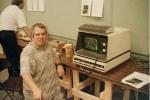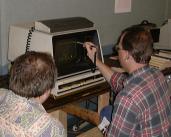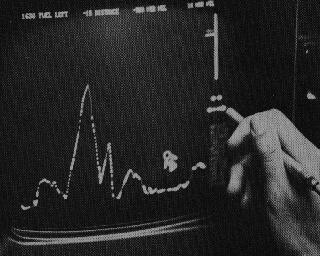DEC GT40 Graphic Display Terminal
The DEC GT40 Graphic Display Terminal is an intelligent terminal based on a
PDP-11/05, first introduced in 1972. A summary of the GT40 features and
characteristics was found in the
PDP-11 Peripherals Handbook.
Vintage Computer Festival

photo by Mike Cheponis
|
Mike Cheponis and I exhibited a GT40 running the Lunar Lander game at the
Vintage Computer Festival
on October 2 & 3, 1999, and
won the Best of Class award in the Minicomputer category.
It's fairly difficult to land the LEM; I've come close a
few times but haven't yet succeeded. One VCF attendee was skillful
enough to do it.
I'd also like to thank Doug Coward, Al Kossow, and Ken Sumrall for their help
in making this exhibit a success.
|

photo by Doug Salot
|
Al and I showed the GT40 at the
DECWORLD 2001 event on June 16, 2001.
Hardware
The GT40 consists of:
- KD11-B (PDP-11/05) central processor
- VT40 display processor, including bootstrap ROM
(same modules as VT11, but instead of the four-slot backplane,
this has a nine-slot backplane to include the CPU and memory)
- MM11-L 8K word core memory (MM11-K 4K word core memory on GT40-Bx models)
- DL11-E asynchronous line interface
- LK40 keyboard
- VR14-LC X-Y monitor (or -LD for 230V)
- 375 light pen
Software
The most famous software for the GT40 was the MOONLANDER game by Jack Burness,
also known as LUNAR LANDER. This was
undoubtedly the inspiration for Atari's coin-operated video game of that name.

Photo 1: The lunar module is controlled by a light pen, and is seen initially
high above a lunar plane.
[Photo and caption from the article "Some Graphics Background Information"
by Ira Jay Rampil (Department of Electrical and Computer Engineering,
University of Wisconsin - Madison), from the November 1976 issue of Byte.]
On 12-Aug-1997, Jack emailed me with some interesting comments on the game:
On early (and mid) versions of the program, after planting the flag (or
getting the cheeseburgers) and the LEM is ready to take off, if you hold
the fuel at 0, the lander will "reland" itself. By doing this you would
get more fuel. The reason is that to insure takeoff, the program
automatically gives you enough fuel to get off. It does this by simply
adding it on to what you have. If you repeatedly "reland" the craft,
eventually you can get enough fuel to take off and explore for some
time. Later versions had the take-off mechanism force the values, but
these could still be overridden by diligently applying the lightpen.
This is "relanding" was a bug found by Herb Jacobs.
You can go through the mountains on the left side if you have enough
speed. And be inside the mountain. This is also another bug, because you
can be travelling so fast that the collision detection routine does not
detect to collision because you've already gone through the wall. No
impact.
You can also land on the plateau on the left side of the mountains by
going over them. This takes quite a bit of skill. Well, practice anyway.
- MOONLANDER by Jack Burness
- Binaries supplied by John Holden:
- lunar.gt ( 17K), GT40 boot loader format
- lunar.lda ( 14K), standard DEC binary load format
- Assembly source code:
The
Spring 1980 RSX SIG tape
contains various VT11 demos, including CRFWAR, a clone of Space War written
in RT-11 Fortran.
I have not yet determined whether this will run on a GT40.
Bootstrap Loader
The GT40 bootstrap loader acts as a very minimal dumb terminal in order
to allow the user to log in to the host computer. It watches for the host
computer to send a special character sequence to initiate
download mode. In download mode it loads a series of memory areas supplied
by the host. The data sent in download mode is encoded with six bits per
character.
I've recreated the GT40's bootstrap loader ROM source code from the listing
in the maintenance manual. It doesn't match the ROMs in my GT40; I'm in
the process of disassembling them and will present the results here when
I'm finished.
John Holden has written
gtencode.c (4.8K),
a utility to convert programs in absolute loader
format or XXDP binary format to suit the bootstrap ROM.
Documentation
Online:
I have these documents:
- GT40 Graphic Display Terminal Maintenance Manual, Volume 1
- GT40 Graphic Display Terminal Maintenance Manual, Volume 2
- GT40 Graphic Display Terminal Engineering Drawings, DEC-11-HGTEA-A-D
- VT11 Graphic Display Processor Technical Manual, EK-VT11-TM-001
I'm looking for copies of these documents:
- GT40 User's Guide, DEC-11-HGTGA-A-D
- GT40 User's Manual, DEC-11-GGTGA-A-D
- PDP-11 Conventions Manual, DEC-11-HR-HR6B-D
- VR14 and VR17 CRT Display User's Manual, DEC-12-HVCRT-D-D
- VR14 and VR20 Troubleshooting Procedures
- Paper-Tape Software Programming Handbook, DEC-11-GGPB-D or DEC-11-GGPC-D
Diagnostics
Diagnostics in GT40 bootstrap loader format, supplied by John Holden:
| Listed in Maintenance Manual
| Available Here
|
|---|
| Title
| Part Number
|
|---|
| GT40 Quick Verify
| MAINDEC-11-DDGTE-A
| dgtec0.gt
( 10K)
|
| GT40 Instruction Test 1
| MAINDEC-11-DDGTA-A
| dgtad1.gt
(9.5K)
|
| GT40 Instruction Test 2
| MAINDEC-11-DDGTB-A
| dgtbd0.gt
(8.0K)
|
| GT40 Visual Display Test
| MAINDEC-11-DDGTC-A
| dgtcc0.gt
(7.3K)
|
| DL11-E, C/D Off-Line Test
| MAINDEC-11-DZDLA
|
| ROM Bootstrap Loader Test
| MAINDEC-11-DDGTD-A-D
| dgtdc0.gt
( 10K)
|
| GT40/GTP Overlay Program
| MAINDEC-11-DDGTF
|
| not listed
| dgtgb0.gt
(7.3K)
|
Pricing
The GT40 pricing from 1974:
| Part Number | Price | Keyboard option | 8-hour Maint
|
|---|
| 115V | 230V
|
|---|
| GT40-AA | GT40-AB | $14,500 | LK40 keyboard | $186
|
| GT40-AC | GT40-AD | $15,720 | LT33 (ASR-33 Teletype) | $223
|
| GT40-AE | GT40-AF | $16,795 | LA30-C (DECwriter I) | $217
|
The GT40-Bx models are equivalent to the -Ax models, but with 4K words of
core rather than the standard 8K.
Brochures
Fredric White has made available scans of the
GT40, GT42, and GT62 brochures.
Other related models
There were several other related models:
- GT44: PDP-11/40 with VT11 display processor
- GT46: PDP-11/34 with VT11 display processor
- GT62: PDP-11/34a with VS60 display system
- VT48: fancier display processor, supporting a superset of the VT11 instruction set, display list subroutines, additional graphics modes including 4K*4K coordinate space
- VR12: variation of VR14 used on PDP-12
- VR17, VR20: larger calligraphic monitors used with the VT11 or VT48
- VR48: large (> 21") calligraphic monitor and display electronics used with VT48
- VS60: display subsystem incorporating VT48 display processor and VR48 monitor
I don't have any information on the GT41, GT42, GT43, GT48, or GT60.
Service
On 15-Aug-1994, Digital announced
that the last service date for the GT40 was to be 31-Oct-1995.
On 1-Jul-1995, Digital announced
that the last service date for the VR12 and VR14 monitors was
to be 31-Jul-1995, and the last service date for the VR17 and VR20
monitors was to be 31-Jul-1996.
Richard Shiffman at one time had this note on his web page regarding the VT11,
VR17, and PDP-11/45:
While working on Danny Cohen's Flight Simulator program, ORLY, Mr. Shiffman
observed that the VR17 display scope's power supply would be damaged if the
PDP-11/45 did a bus reset and the scope's power left on for an extended period
of time. The VR17 display is a random beam positioning scope with the physical
origin (point 0,0) in the center of the screen, this is the point of least
power consumption. The VT11 display processor had its logical origin at the
lower left-hand corner of the display. This is the state of maximum power
consumption for the VR17. This condition would occur every time there was a
bus-reset on the PDP-11/45. The solution was to construct a circuit that would
disconnect the outputs of the VT11 from the VR17 and ground the inputs to the
deflection amplifiers when the VT11 was at its logical origin and idle. Now
the VR17 would consume minimal power when the VT11 was idle.
Even though the GT40 uses a VR14 and PDP-11/05, it is likely that the
information is applicable.
Thanks to Douglas A. Gwyn for providing information on the GT62, VS60, VT48, and
VR48.
 Back to my Retrocomputing page
Back to my Retrocomputing page
 Back to my home page
Back to my home page
Last updated October 12, 2002
Copyright 1996, 1997, 1998, 1999, 2001, 2002 Eric Smith
eric@brouhaha.com

 check now
check now



 Back to my Retrocomputing page
Back to my Retrocomputing page
 Back to my home page
Back to my home page